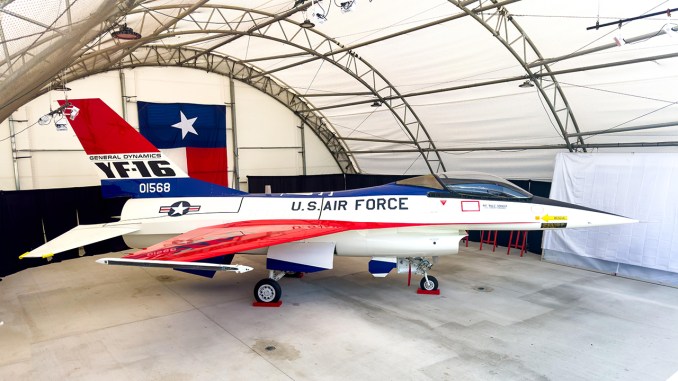
It took 4 years and over 10,000 hours of volunteer work to get the YF-16 #72-01568 to its original appearance.
On Saturday, June 1, 2024, the Fort Worth Aviation Museum unveiled the second YF-16 prototype, airframe #72-01568, that was given the same configuration the aircraft had when it carried out its first flight 50 years ago, on May 9, 1974.
The aircraft was given again its iconic paint scheme, the same sported by the U.S. Air Force F-16 Viper Demo team to celebrate the 50 years of the Fighting Falcon (nicknamed “Viper” by its pilots all around the world).
The second YF-16 prototype (tail number 72-01568) was one of two built to compete in the Lightweight Fighter Program (LWF) in the early 1970s. It was designed and constructed in Fort Worth before being transported to California for flight testing against the YF-17. After winning the LWF competition, the F-16 was selected as the frontline multi-role fighter by the USAF and 29 other air forces globally.
YF-16
The first YF-16 was revealed at a rollout ceremony in Fort Worth on Dec. 13, 1973, and made its initial flight on Jan. 20, 1974.
On that day, General Dynamics test pilot Phil Oestricher brought the YF-16 No.1 onto the runway at Edwards Air Force Base, California, for a high-speed taxi test up to 135 knots to assess the pre-takeoff handling characteristics before the scheduled first flight two weeks later. However, events took an unexpected turn when Oestricher was forced to lift off to save the aircraft after a series of large oscillations caused it to bounce multiple times on the main landing gear and strike the runway with the right horizontal stabilizer.
“We’d progressively taxied the airplane faster and faster and wanted to get a better idea of how it handled,” explained Oestricher. “Few people know this, but we actually intended to lift the airplane off the ground that day. Our intention was to move the throttle to military power for a few seconds and let the main gear come up a couple of feet while we went down the runway.”
“We encountered two problems,” Oestricher continued. “First, the roll control was too sensitive, too much roll rate as a function of stick force. Second, the exhaust nozzle control for the prototype was wired incorrectly. You had to be on the ground for the nozzle to be wide open, so as soon as you took the weight off the wheels, the nozzle closed and essentially doubled the thrust at idle.”
To avoid losing the aircraft, Oestricher increased the power and took off, safely landing six minutes later after flying a wide pattern around the runway. Engineers resolved the control issue by that evening, and although the repairs took a bit longer, they allowed the first flight to proceed as scheduled two weeks later, on February 2.
YF-16 #2
The second YF-16 first flew on May 9, 1974, with Neil Anderson piloting. This prototype was fully equipped for weapons and external fuel tanks, unlike the first, which focused on aerodynamic and handling qualities tests. The second aircraft also underwent various paint schemes for different testing phases.
According to F16.net, the aircraft experienced a few tense moments during its initial two flights. During both landings, the nose landing gear (NLG) failed to fully extend. Ground tests for gear extension and retraction had gone smoothly, so no issues were anticipated during flight. However, because the NLG extends downward and forward, the air pressure at 200 knots during extension hindered full deployment. Pilot Neal Anderson attempted to extend the gear at a lower airspeed and even pulled 3g, but nothing worked. Then, he flipped the alternate flap switch, and the resulting hydraulic pressure pulse was just enough to lock the gear in place. About 50 people in the control room breathed a collective sigh of relief. After the flight, adjustments were made to the gear rigging to fix the issue. However, on the second flight, the problem recurred, much to Neal’s frustration.
After its testing and demonstration phase, YF-16 #2 was used extensively, logging over 900 flight hours before being repurposed by the Air Force Research Lab in Rome, New York, for antenna testing on production F-16s. During the early years it also got different testing paint schemes.
YF-16 #2 in a blue and white camouflage scheme (USAF)
” data-medium-file=”https://i0.wp.com/theaviationist.com/wp-content/uploads/2024/06/YF-16-in-a-camouflage-color-scheme.jpg?fit=460%2C306&ssl=1″ data-large-file=”https://i0.wp.com/theaviationist.com/wp-content/uploads/2024/06/YF-16-in-a-camouflage-color-scheme.jpg?fit=706%2C470&ssl=1″ class=”size-large wp-image-86584″ src=”https://zephyrnet.com/wp-content/uploads/2024/06/second-of-two-yf-16s-restored-to-its-former-paint-scheme-and-configuration-1.jpg” alt width=”706″ height=”470″ srcset=”https://zephyrnet.com/wp-content/uploads/2024/06/second-of-two-yf-16s-restored-to-its-former-paint-scheme-and-configuration-1.jpg 706w, https://zephyrnet.com/wp-content/uploads/2024/06/second-of-two-yf-16s-restored-to-its-former-paint-scheme-and-configuration-3.jpg 460w, https://zephyrnet.com/wp-content/uploads/2024/06/second-of-two-yf-16s-restored-to-its-former-paint-scheme-and-configuration-4.jpg 128w, https://zephyrnet.com/wp-content/uploads/2024/06/second-of-two-yf-16s-restored-to-its-former-paint-scheme-and-configuration-5.jpg 768w, https://i0.wp.com/theaviationist.com/wp-content/uploads/2024/06/YF-16-in-a-camouflage-color-scheme.jpg?w=800&ssl=1 800w” sizes=”(max-width: 706px) 100vw, 706px” data-recalc-dims=”1″>
This aircraft continued to serve in this role for 40 years making it the longest-serving F-16 ever.
Restoration
According to FW Museum, in 2019, the aircraft was identified by museum staff as being declared surplus by the Air Force and requested for restoration and display.
After its final flight in 1979, YF-16 #2 was utilized as an antenna test model for 40 years, undergoing significant modifications by Rome Labs. Thanks to the efforts of U.S. Representative Kay Granger, the aircraft was transferred to the Fort Worth Aviation Museum by the USAF. The plane, which is on loan from the National Museum of the United States Air Force, is currently being restored.
In 2020, the Fort Worth Aviation Museum began restoring YF-16 #2 to its 1975 configuration and paint scheme to honor its historical significance and the contributions of those involved in the F-16 program.
The museum has also acquired artifacts from the YF-16 program, including personal items from test pilots Phil Oestricher and Neil Anderson. These collections are enhanced by donations from former GD and Lockheed Martin employees who worked on the F-16 program.
The initial YF-16s were indeed the forerunners of over 4,600 F-16s produced worldwide, with 3,640 of those built at Fort Worth Air Force Plant No. 4 and the rest assembled at co-production facilities around the world using parts manufactured in Fort Worth.
- SEO Powered Content & PR Distribution. Get Amplified Today.
- PlatoData.Network Vertical Generative Ai. Empower Yourself. Access Here.
- PlatoAiStream. Web3 Intelligence. Knowledge Amplified. Access Here.
- PlatoESG. Carbon, CleanTech, Energy, Environment, Solar, Waste Management. Access Here.
- PlatoHealth. Biotech and Clinical Trials Intelligence. Access Here.
- Source: https://theaviationist.com/2024/06/02/second-of-two-yf-16s-restored-to-its-former-paint-scheme-and-configuration/




